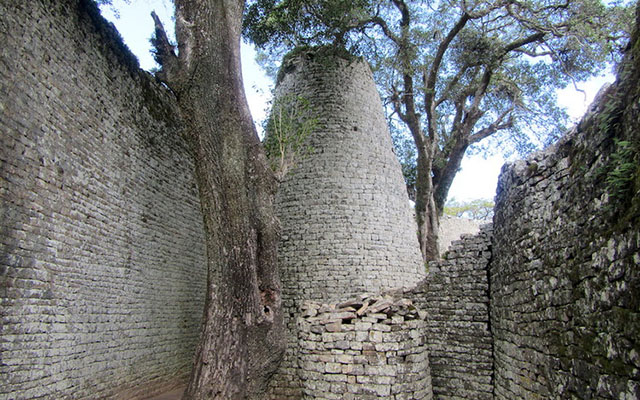Unravelling the mystery of Great Zimbabwe


Although local experts have also added their bit to the existing information that provides us with the knowledge and understanding of Great Zimbabwe’s various facets, the bulk of the available literature is by Western scholars
Tendai Manzvanzvike Literature Today
A UNESCO World Heritage site, the Great Zimbabwe Monuments in Masvingo Province, remains a wonder and a work in progress not in terms of construction, but in terms of unearthing the mysteries that make up this majestic structure. Although a majority of stuff about Great Zimbabwe has been researched on and written about over the centuries, the mysticism continues to attract researchers to try and search for new evidence, thereby adding on the existing literature by archaeologists, historians, anthropologists, sociologists, economists and cultural experts. Although local experts have also added their bit to the existing information that provides us with the knowledge and understanding of Great Zimbabwe’s various facets, the majority of the available literature is by Western scholars.
But Cosmas Nyamutswa, whose book “Great Zimbabwe: Who Built it and Why?” published recently by Themba Books, is neither an archaeologist nor historian, but he is a professional pilot with an eagle’s eye view. On several occasions he has flown “over Great Zimbabwe” — the national historical monument displaying Zimbabwe’s “national pride to local and international travellers”.
By so doing, he allowed the things that he is passionate about to define him as his adventures steered him toward the search for his identity. But it turns out that his is not only a search of his persona, but a search for something bigger — Zimbabwe’s identity. Nyamutswa’s appetite to understand his family tree and how it is interlinked with others that saw him eventually writing the book he had never imagined he would write. He says in the preface: “. . . While I was researching on my family, I had a book on the Nyamutswa family in mind. However, in the process of researching, I also got to know other family groupings in Zimbabwe.”
Nyamutswa says, he took “a particular interest in those people with Mwenye totems. As I did so, I kept hearing from these people references to Great Zimbabwe. Initially, I thought of writing a newspaper article . . . But as I continued working, the story began to look a lot more significant than I had first anticipated.”
He also says what drove him to embark on the massive research and writing of the book was that he was “struck by the fact that to date, very little is known about the history of Great Zimbabwe. Considering the sheer volume on the history of Zimbabwe put together by luminaries in the field, what is actually known about Great Zimbabwe is disappointingly little,” (adding), “we are as yet unable to provide a convincing historical narrative to explain our greatest archaeological attraction.”
But, is Nyamutswa’s postulation on the people he claims built Great Zimbabwe and why they did it convincing, and will it be accepted in the scholarly world where it will be subjected to forensic scrutiny, notwithstanding that he also heavily relied on other scholarly material, for sound research has to withstand those benchmarks? It waits to be seen whether it stands the test of time, but Nyamutswa has to be commended for becoming another voice on knowledge creation and accumulation.
His publisher also believes that he has managed to convince readers on his theory on who built Great Zimbabwe as they state in the book’s blurb that Nyamutswa “looks at the different theories with which various writers have tried to answer this question. He finds none of them satisfactory and comes up with a new one, one that some have hinted at, but never been able to develop into a comprehensive explanation of what the ancient ruins really were and who built them, Nyamutswa does that.”
The contents page also speak for itself where in the 10 chapters Nyamutswa looks at the exogenous and endogenous theories about Great Zimbabwe’s historiography and the evaluation of current theories. In the second part, he introduces a central people — the Mwenye people — and examines their culture and origins.
In another chapter, he talks about the reasons for building Great Zimbabwe, before he poses the million dollar question: “Who built Great Zimbabwe?”
Nyamutswa states: “It has been possible to determine with a high degree of probability, the function of Great Zimbabwe. Based on that probability, the way is open to determining with a similar degree of probability who the builders of Great Zimbabwe were. Given the function of Great Zimbabwe, it is clear that only a people, who had a culture in which circumcision was absolutely central and definitive in their lives, could have taken the trouble to build Great Zimbabwe.”
Nyamutswa also includes a number of plates with images from Great Zimbabwe that symbolise human sexuality among other social and cultural, economic aspects. The conical tower is one of such symbols.
He adds, “Suggest to people for whom circumcision is either peripheral or of no concern whatsoever that Great Zimbabwe was built as a circumcision site, and they will and do respond by expressing astonishment that all that work , all those buildings, were just for circumcision! All this just for the performance of the simple task of circumcision, they might ask.”
But who are these people that are central to the construction of Great Zimbabwe? After narrating their background in earlier chapters, Nyamutswa presents the Mwenye people’s claim that they build Great Zimbabwe. He cites the Lemba burial song that outlines their origins and their subsequent movements (that) goes: “The tribes went to Zimbabwe /they built the walls and lived on the hill,” as they “persistently and continuously allege that they are builders of Great Zimbabwe.”
Nyamutswa’s ending is not only assertive, but quite controversial among schools of thought that argue that Africans could not have built Great Zimbabwe, which would also question its ownership.
He ends with a bold statement: “Great Zimbabwe is African.” He partially argues, “Historians and archaeologists have tended to sail with the political and nationalistic winds, sometimes in the name of patriotism — at others, perhaps fear. This has been done at a significant cost to academic integrity as Zimbabwe’s history has remained half-baked. However, Nyamutswa concludes that “the groups, which have been associated with Great Zimbabwe, constitute a significant proportion of all groups in Zimbabwe.”
But why would a professional pilot be interested in all this in the first place? Why also would he delve into such a controversial subject? For posterity, or for what? Stone by stone, shape by shape, the Great Zimbabwe came up, and Nyamutswa’s nature saw that he might as well sculpt his own genealogy?
When he wrote opinion pieces about Ngoma Lungundu (the assumed lost Ark of the Covenant), while it was a topical issue in Zimbabwe, especially among the scholarly world and the Remba/Lemba people, Nyamutswa gave his ten cents worth. Maybe this was part of his symbolic rites of passage into manhood.









Comments